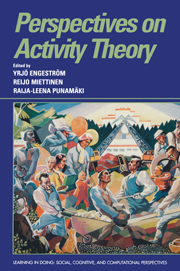Book contents
- Frontmatter
- Contents
- List of contributors
- Series foreword
- Introduction
- Part I Theoretical issues
- Part II Language and its acquisition
- Part III Play, learning, and instruction
- Part IV Technology and work
- Part V Therapy and addiction
- 24 Object relations theory and activity theory: A proposed link by way of the procedural sequence model
- 25 The concept of sign in the work of Vygotsky, Winnicott, and Bakhtin: Further integration of object relations theory and activity theory
- 26 From addiction to self-governance
- Author index
- Subject index
24 - Object relations theory and activity theory: A proposed link by way of the procedural sequence model
Published online by Cambridge University Press: 05 June 2012
- Frontmatter
- Contents
- List of contributors
- Series foreword
- Introduction
- Part I Theoretical issues
- Part II Language and its acquisition
- Part III Play, learning, and instruction
- Part IV Technology and work
- Part V Therapy and addiction
- 24 Object relations theory and activity theory: A proposed link by way of the procedural sequence model
- 25 The concept of sign in the work of Vygotsky, Winnicott, and Bakhtin: Further integration of object relations theory and activity theory
- 26 From addiction to self-governance
- Author index
- Subject index
Summary
Introduction
The aim of this chapter is to consider the relationship between two theories of very different origins, namely, object relations theory and activity theory. The idea of linking the two theories was derived from my development of the procedural sequence model, which evolved in parallel with the development of an integrated approach to psychotherapy – cognitive analytic therapy (Ryle, 1982, 1990). The procedural sequence originated as a restatement, in cognitive terms, of ideas from both cognitive-behavioral and psychoanalytic therapies; the resemblance of this model to aspects of activity theory was pointed out by my colleague Mikael Leiman, and the present exploration was initiated by discussions with him.
In this chapter 1(1) present the basic features of the procedural sequence model; (2) outline the way in which ideas from object relations theory were incorporated in it; (3) describe briefly the ideas of Vygotsky and activity theory; and (4) consider the compatibility and complementarity between activity theory and the procedural sequence and object relations models.
Development of the procedural sequence model
A full account of the development of cognitive analytic therapy and of the procedural sequence model will be found in Ryle (1990). This time-limited therapeutic approach has, as its central feature, the joint elaboration by the patient and therapist of a written reformulation of the patient's problems. This takes the form of a letter describing the patient's past history and the strategies developed to cope with it, as well as a description of the patient's current maladaptive “procedures.”
Information
- Type
- Chapter
- Information
- Perspectives on Activity Theory , pp. 407 - 418Publisher: Cambridge University PressPrint publication year: 1999
Accessibility standard: Unknown
- 5
- Cited by
